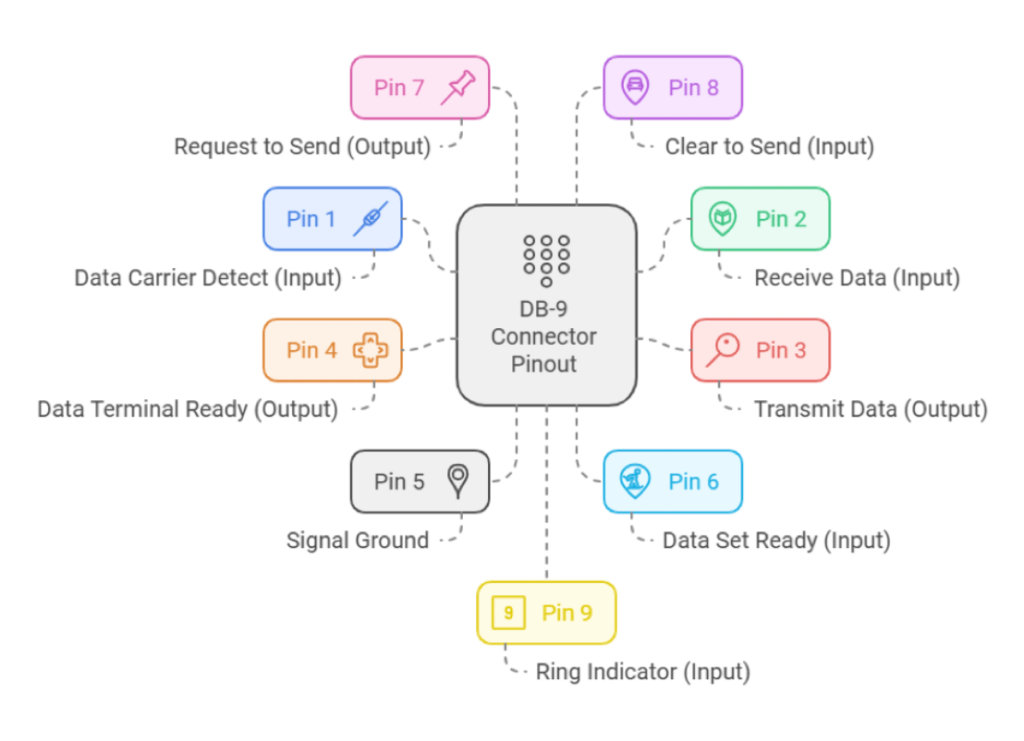Introduction
This article will explain RS-232C’s functioning, specifications, applications, features, and more.
Article Directory
- Introduction
- What is Interface RS232C?
- How Does Interface Rs 232c Work?
- Electrical and Mechanical Specification of Interface Rs 232c
- DB-9 Connector Pinout Table
- Application of RS232C
- Limitations of RS-232C
- What is TTL?
- TTL vs. RS-232: A Comparison Table
- FAQs
- Conclusion
What is Interface RS232C?
The interface RS-232C is a serial communication protocol that transmits data between the devices using a single cable. The communication standard utilizes voltage level changes to distinguish between bits and bytes of data.
RS232C voltage levels are +15 volts to -15 volts. The positive voltage indicates logic 1 and the negative voltage indicates logic 0. The data transmission manner of RS232C is bit-by-bit. A single byte in the interface RS 232C consists of a data bit, start bit, parity bit, and stop bit.

How Does Interface Rs 232c Work?
The interface RS 232C uses a serial data communication method to transmit one bit at a time over a single wire. Serial communication offers a simpler and more cost-effective solution for shorter distances.
The interface RS 232C follows an asynchronous data transmission method. Here the sending and receiving devices work independently with no shared clock signal. The start and stop bits are added to each data byte for synchronization.
RS 232 is a full duplex communication protocol. DTE and DCE can transmit and receive data simultaneously at interface RS 232C which enables two-way communication. RS-232 uses negative and positive voltage levels to represent binary data.
Interface RS 232C communication protocol controls signals like Request to Send (RTS), Clear to Send (CTS), Data Set Ready (DSR), and Data Terminal Ready (DTR). These ensure proper data flow and prevent data loss.
The RTS and CTS are the most used handshake signals of RS 232C. These signals ensure proper data integrity. Devices ensure data transmission by using these signals.
Electrical and Mechanical Specification of Interface RS 232C
The RS-232C serial binary data communication has some specific electrical and mechanical characteristics.
Key Electrical Specifications of RS 232C:
- Voltage Levels: In RS232, logic 1 works with -5V to -15Vdc, and logic 0 works with +5V to +15Vdc. Binary logic 0 is called ON or spacing and binary logic 1 is called OFF or making in the communication standard.
- Maximum Bit Rate: The maximum bit rate of RS232 is 20 Kbps. It can vary depending on cable length and other factors.
- Driver Output Impedance: The line impedance of the output cable is between 3k ohms and 30k ohms.
- Receiver Input Impedance: The receiver cable input impedance is between 3k ohms and 30k ohms.
- Operational Voltage: The maximum operational voltage of RS232 is 250V AC.
- Rated Current: The maximum current rating of the cable is 3 Amps.
- Dielectric Voltage: The minimum withstanding dielectric voltage of RS232 is 1000 VAC.
- Slew Rate: The RS-232 standard specifies a maximum slew rate of 30 V/µs. The slew rate refers to the rate at which the signal level changes.
Key Mechanical Specifications of RS 232C:
We need to study DB-9 or DB-25 connectors for the mechanical characteristics of the communication standard. The DB-25 connector has 25 pins. You may need to use all pins for some applications. But sometimes you need not use the whole pins of DB-25. Hence arises the DB-9 connector for convenience.
DB-9 connector is used to connect the microcontroller with the connector. There are two types of DB-9 connectors:
- Male Connector (DTE)
- Female Connector (DCE)
The other name for DB-9 connector is D-type connector or DE-9.

DB-9 Connector Pinout Table
| Pin No. | Signal Name | Function |
| 1 | DCD | Data Carrier Detect (Input) |
| 2 | RDX | Receive Data (Input) |
| 3 | TXD | Transmit Data (Output) |
| 4 | DTR | Data Terminal Ready (Output) |
| 5 | GND | Signal Ground |
| 6 | DSR | Data Set Ready (Input) |
| 7 | RTS | Request to Send (Output) |
| 8 | CTS | Clear to Send (Input) |
| 9 | RI | Ring Indicator (Input) |
Application of RS232C
RS232C was the most popular communication standard in the past. It was widely used to connect peripherals like printers and modems to the computer. Despite the rise of new and advanced interface standards like Ethernet and USB, RS232C still has applications in industries and automation.
The following are the key uses of RS232C.
- Industrial Automation: RS232C is widely used in automation. It is used in programming and configuring industrial control systems (PLCs), Human-Machine Interfaces (HMIs), and industrial sensors.
- Point-of-Sale (POS) Systems: The RS232C communication standard connects cash registers, barcode scanners, and receipt printers with computers.
- Medical Equipment: Programming and data transfer from medical devices like EKG machines and pulse oximeters utilize RS-232C connections.
- Traditional Computer Systems and Equipment: Many older computer systems, machinery, and scientific instruments still rely on RS-232. It ensures compatibility with existing infrastructure.
Limitations of RS-232C
Though RS-232 has many advantages, it has some limitations. The lack of Interface Rs 232C is:
- Slow Data Transfer Speeds: RS-232 has a maximum data transfer rate of around 20 kbps which is significantly slower than newer technologies like USB and Ethernet.
- RS232 Distance Limitation: RS-232 max length is 50 feet (15 meters). Because it causes signal degradation over longer distances.
- Point-to-Point Communication: RS-232 supports only direct communication between two devices (DTE and DCE).
- Complex Configuration: Setting up RS-232 connections is more complex than the newer interfaces. Interface RS-232C requires baud rate, parity, and stop-bit configuration for data transfer.
These limitations have led to the rise of alternative protocols like USB and Ethernet.
What is TTL?
TTL, short for Time to Live, is a technique used to determine how long a data packet should remain on a network before being discarded.
This mechanism helps prevent packet loops, stopping the endless circulation of data packets caused by misconfigurations or routing errors. By limiting the lifespan of data packets, TTL also contributes to reducing network congestion.
TTL vs RS232: A Comparison Table
| Feature | TTL | RS232 |
| Voltage Levels | TTL has voltage levels of 0V (low) and 5V (high) | RS232 has voltage level of -12V (low), +12V (high) |
| Signal Type | It is single-ended | It is differential |
| Maximum Cable Length | The cable length of TTL is a few meters for short distances | RS232 has several meters of cable length for longer distances than TTL |
| Noise Immunity | Lower | Higher |
| Data Rate | Lower | Higher |
| Complexity | TTL is simpler | RS232 is complex |
| Common Applications | TTL used in microcontrollers, sensors, and short-distance communication | It has an application in serial communication between devices like modem |
FAQs
What is Handshaking?
Handshaking is a communication process between two devices before transmitting real data. The transmitter and receiver exchange primary data using the handshaking method.
Handshaking ensures that both devices operate at the same speed and timing to make the synchronization. It helps in identifying and detecting errors that occur during data transmission. It also regulates the data flow to avoid overloading the receiving device. Handshaking authenticates devices and establishes secure connections.
There are three types of handshaking methods available:
- No Handshaking: No handshaking means the DCE will read the previously received data and DTE will start transmitting the next data.
- Hardware Handshaking: Hardware handshaking relies on specific control signals such as RTS (Request to Send), CTS (Clear to Send), DTR (Data Terminal Ready), and DSR (Data Set Ready) to indicate when devices are prepared to send and receive data.
RS-232 serial communication often uses hardware handshaking. - Software Handshaking: It relies on software protocols to coordinate data exchange. XON/XOFF protocol is a common example of software handshaking.
Why is RS-232 still used?
USB has replaced the RS-232 for personal computers. But it is still popular in places like networking equipment, and industrial machinery due to its simplicity.
The main factors contributing to the persistence of the RS-232 are its cost-effectiveness, ruggedness, and ease of troubleshooting and maintenance.
Is RS-232 analog or digital?
The RS-232 serial communication protocol is analog.
Is RS-232 simplex or duplex?
RS-232 is a full duplex communication protocol mode.
What is the maximum distance for RS-232 communication?
The maximum communication distance for RS-232 is 15 meters (50 feet). This length can vary depending on the cable quality, data rate, and environmental conditions.
You can increase the distance by RS-232 to RS-422/485 converters up to 100 meters.
Conclusion
Communication protocol is one of the basic elements of data transmission. The interface RS232C is the oldest serial communication standard. The article described the RS232C in detail to give an overall idea about this data transmission standard.
If you have any difficulties understanding it, feel free to contact us.


